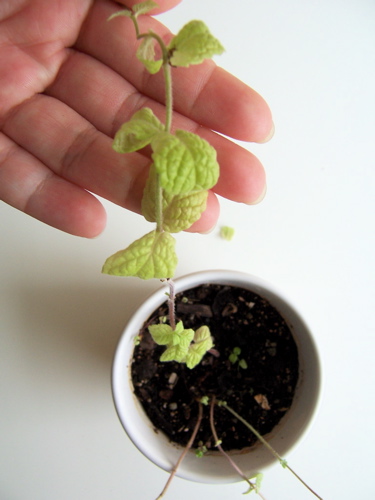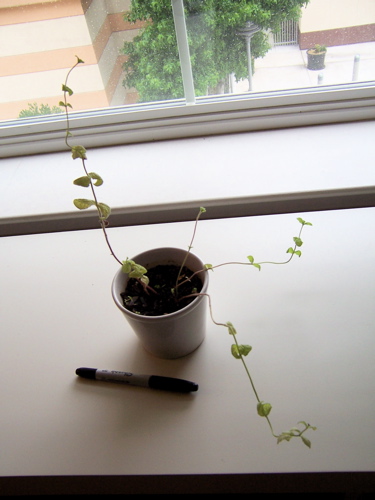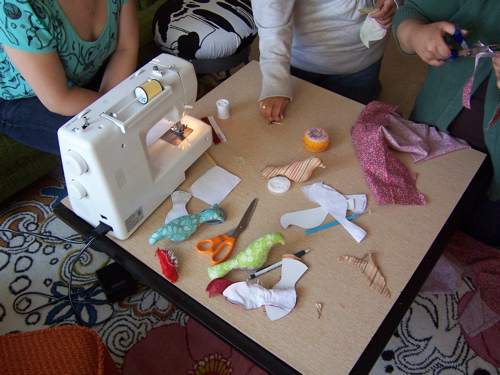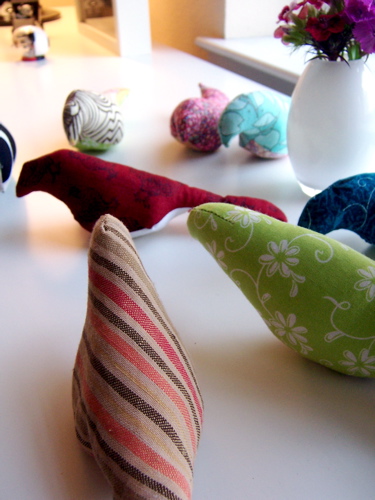 It was a quiet Friday night at home last night because I had been struck by a bad attack of allergies. A perfect night to ply those yarn singles that I had finished before Moocow came to visit. (Moocow has the pictures from her visit, so I am waiting for her to send them to me, or post some herself).
It was a quiet Friday night at home last night because I had been struck by a bad attack of allergies. A perfect night to ply those yarn singles that I had finished before Moocow came to visit. (Moocow has the pictures from her visit, so I am waiting for her to send them to me, or post some herself).I don't have a lot of fancy spinning equipment. Just my drop spindle and my hands. I did want to make a 2-ply yarn, though. (That is, a yarn made by spinning two singles together.) Without another drop spindle, bobbins, a lazy kate, or even a ball winder, I decided that my best option was to experiment with the Andean Plying technique.
What does the Andean Plying technique do? Well, it is a method of winding yarn singles off of a single spindle - and onto your hand - in such a way as to produce a centre-pull "bracelet" of yarn, from which you can pull both ends of yarn at once, without creating a tangled mess. That means that you can make a 2-ply yarn from just one ball of yarn, instead of working off of two spindles, two bobbins, or two separately wound balls of singles.
I decided to follow the winding-off technique on Mielke Fibers' page, because they had decent diagrams. Then, off I went, winding away. It looks complicated to begin with, but soon I watched in amazement (then, in mounting concern) as more yards of yarn singles than I had imagined began to accumulate on my left hand. I quickly came to understand why others have written that their middle finger begins to turn blue.

- Before you start Andean Plying, eat and drink something, go to the bathroom, turn on your answering machine, and make sure nothing is on the stove. Once you start, you have to finish!
- When the instructions say to keep track of the ends, they mean it! Don't lose that loose end that you started with amidst your growing ball of yarn. Believe me. I learned this the painful way; I had to rewind my bracelet because I couldn't find my other end! (See how super-neat my ball of yarn is, with just a single loose end? That isn't the goal for Andean Plying.)
- I like my middle finger, and don't want to lose it. Don't try to remove the yarn by manipulating your finger. Ouch! You slip the ball of yarn off your hand as you would a boxing glove. Then, you slip the resulting bracelet around your wrist.
- Do not overload your drop spindle with singles. You fingers (mainly, your middle finger) is only so long. You may run out of room on your hand if you have too much yarn to wind on.
- I want a Handy Andy, to save me further pain and frustration.
If you think about it, whoever invented the Andean Plying technique was a genius. A sadistic/masochistic genius, but a genius all the same. Trust the instructions, follow the directions, and it really works!
 So, having had the opportunity to practice my winding technique twice, with the bracelet of yarn on my left wrist and the two ends of singles firmly in hand, I proceeded to spin/ply them onto my drop spindle. I was surprised by the change in texture that the plying produced. Whereas the singles were fairly solid, firm threads (probably overspun by yours truly), the plied yarn was softer and fluffier.
So, having had the opportunity to practice my winding technique twice, with the bracelet of yarn on my left wrist and the two ends of singles firmly in hand, I proceeded to spin/ply them onto my drop spindle. I was surprised by the change in texture that the plying produced. Whereas the singles were fairly solid, firm threads (probably overspun by yours truly), the plied yarn was softer and fluffier. Since I didn't have a skeinwinder/yarn swift or a niddy noddy, I wound my plied yarn off of the drop spindle and onto the back of a chair.
Since I didn't have a skeinwinder/yarn swift or a niddy noddy, I wound my plied yarn off of the drop spindle and onto the back of a chair. Then, I tied four sections around the skein with figure-8 ties, to keep the skein tangle-free.
Then, I tied four sections around the skein with figure-8 ties, to keep the skein tangle-free. Here's a close-up of the figure-8 tie (and the yarn!).
Here's a close-up of the figure-8 tie (and the yarn!). Then, I soaked the tied off skein in some Eucalan, a lavender scented wool wash with lanolin.
Then, I soaked the tied off skein in some Eucalan, a lavender scented wool wash with lanolin. Soaking the plied yarn relaxes the yarn and evens out any extra twist from over-spinning, so that the finished yarn is balanced, bouncy, and ready for knitting.
Soaking the plied yarn relaxes the yarn and evens out any extra twist from over-spinning, so that the finished yarn is balanced, bouncy, and ready for knitting. Squeeze (don't twist! or rub!) the water out of your skein of yarn and press it in some towels to remove most of the moisture.
Squeeze (don't twist! or rub!) the water out of your skein of yarn and press it in some towels to remove most of the moisture. Then, hang the skein up and hang a small weighted object at the bottom of the loop to balance that twist. I just hung another clothes hanger on the bottom, weighted with a little pouch with things inside it.
Then, hang the skein up and hang a small weighted object at the bottom of the loop to balance that twist. I just hung another clothes hanger on the bottom, weighted with a little pouch with things inside it. That skein of yarn is still drying, but I will have pictures of the finished yarn soon. Now that I have gone through the entire process once, I feel ready to spin the wine red corriedale that Moocow chose, way back when, for me to spin so that she could knit a pair of Elizabeth Zimmermann mittens.
That skein of yarn is still drying, but I will have pictures of the finished yarn soon. Now that I have gone through the entire process once, I feel ready to spin the wine red corriedale that Moocow chose, way back when, for me to spin so that she could knit a pair of Elizabeth Zimmermann mittens.



























